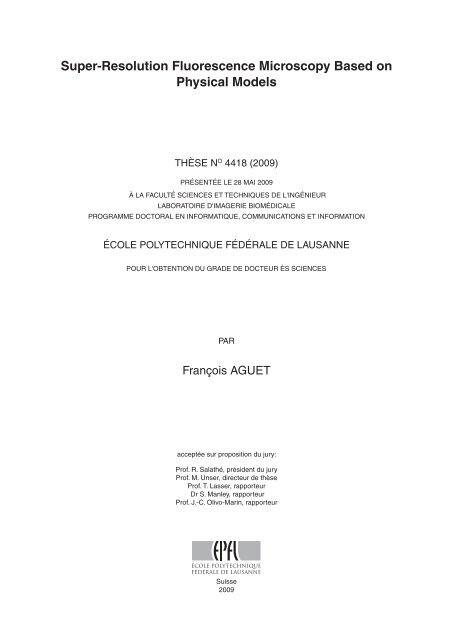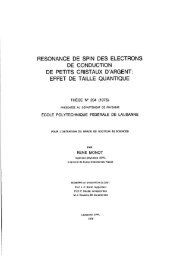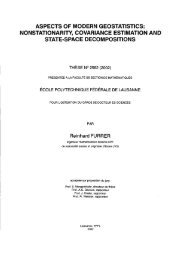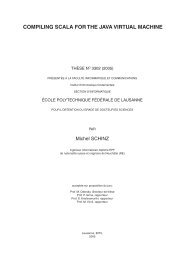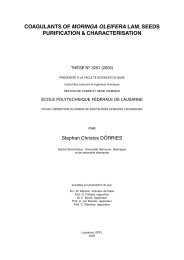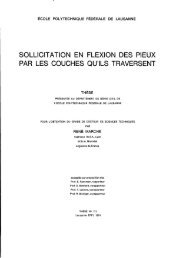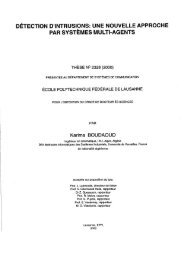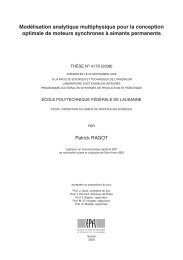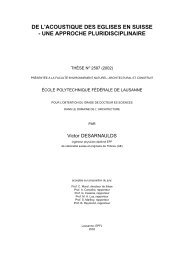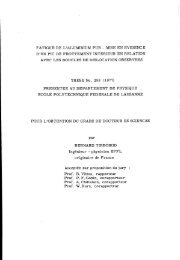Super-Resolution Fluorescence Microscopy Based on Physical ...
Super-Resolution Fluorescence Microscopy Based on Physical ...
Super-Resolution Fluorescence Microscopy Based on Physical ...
You also want an ePaper? Increase the reach of your titles
YUMPU automatically turns print PDFs into web optimized ePapers that Google loves.
<str<strong>on</strong>g>Super</str<strong>on</strong>g>-<str<strong>on</strong>g>Resoluti<strong>on</strong></str<strong>on</strong>g> <str<strong>on</strong>g>Fluorescence</str<strong>on</strong>g> <str<strong>on</strong>g>Microscopy</str<strong>on</strong>g> <str<strong>on</strong>g>Based</str<strong>on</strong>g> <strong>on</strong><br />
<strong>Physical</strong> Models<br />
THÈSE N O 4418 (2009)<br />
PRÉSENTÉE LE 28 MAI 2009<br />
À LA FACULTÉ SCIENCES ET TECHNIQUES DE L'INGÉNIEUR<br />
LABORATOIRE D'IMAGERIE BIOMÉDICALE<br />
PROGRAMME DOCTORAL EN INFORMATIQUE, COMMUNICATIONS ET INFORMATION<br />
ÉCOLE POLYTECHNIQUE FÉDÉRALE DE LAUSANNE<br />
POUR L'OBTENTION DU GRADE DE DOCTEUR ÈS SCIENCES<br />
PAR<br />
François AGUET<br />
acceptée sur propositi<strong>on</strong> du jury:<br />
Prof. R. Salathé, président du jury<br />
Prof. M. Unser, directeur de thèse<br />
Prof. T. Lasser, rapporteur<br />
Dr S. Manley, rapporteur<br />
Prof. J.-C. Olivo-Marin, rapporteur<br />
Suisse<br />
2009
Abstract<br />
is thesis introduces a collecti<strong>on</strong> of physics-based methods for superresoluti<strong>on</strong><br />
in optical microscopy. e core of these methods c<strong>on</strong>stitute a<br />
framework for 3-D localizati<strong>on</strong> of single uorescent molecules. Localizati<strong>on</strong><br />
is formulated as a parameter estimati<strong>on</strong> problem relying <strong>on</strong> a physically<br />
accurate model of the system’s point spread functi<strong>on</strong> (PSF). In a similar approach,<br />
methods for tting PSF models to experimental observati<strong>on</strong>s and for<br />
extended-depth-of-eld imaging are proposed.<br />
Imaging of individual uorophores within densely labeled samples has<br />
become possible with the discovery of dyes that can be photo-activated or<br />
switched between uorescent and dark states. A uorophore can be localized<br />
from its image with nanometer-scale accuracy, through tting with<br />
an appropriate image functi<strong>on</strong>. is c<strong>on</strong>cept forms the basis of uorescence<br />
localizati<strong>on</strong> microscopy (FLM) techniques such as photo-activated<br />
localizati<strong>on</strong> microscopy (PALM) and stochastic optical rec<strong>on</strong>structi<strong>on</strong> microscopy<br />
(STORM), which rely <strong>on</strong> Gaussian tting to perform the localizati<strong>on</strong>.<br />
Whereas the image generated by a single uorophore corresp<strong>on</strong>ds to a<br />
secti<strong>on</strong> of the microscope’s point spread functi<strong>on</strong>, <strong>on</strong>ly the in-focus secti<strong>on</strong><br />
of the latter is well approximated by a Gaussian. C<strong>on</strong>sequently, applicati<strong>on</strong>s<br />
of FLM have for the most part been limited to 2-D imaging of thin specimen<br />
layers.<br />
In the rst secti<strong>on</strong> of the thesis, it is shown that localizati<strong>on</strong> can be extended<br />
to 3-D without loss in accuracy by relying <strong>on</strong> a physically accurate<br />
image formati<strong>on</strong> model in place of a Gaussian approximati<strong>on</strong>. A key aspect<br />
of physically realistic models lies in their incorporati<strong>on</strong> of aberrati<strong>on</strong>s that<br />
arise either as a c<strong>on</strong>sequence of mismatched refractive indices between the<br />
layers of the sample setup, or as an effect of experimental settings that deviate<br />
from the design c<strong>on</strong>diti<strong>on</strong>s of the system. Under typical experimental<br />
c<strong>on</strong>diti<strong>on</strong>s, these aberrati<strong>on</strong>s change as a functi<strong>on</strong> of sample depth, inducing<br />
axial shift-variance in the PSF. is property is exploited in a maximumlikelihood<br />
framework for 3-D localizati<strong>on</strong> of single uorophores. Due to the<br />
shift-variance of the PSF, the axial positi<strong>on</strong> of a uorophore is uniquely encoded<br />
in its diffracti<strong>on</strong> pattern, and can be estimated from a single acquisi-<br />
i
ii<br />
ti<strong>on</strong> with nanometer-scale accuracy.<br />
Fluroescent molecules that remain xed during image acquisiti<strong>on</strong> produce<br />
a diffracti<strong>on</strong> pattern that is highly characteristic of the orientati<strong>on</strong> of the<br />
uorophore’s underlying electromagnetic dipole. e localizati<strong>on</strong> is thus extended<br />
to incorporate the estimati<strong>on</strong> of this 3-D orientati<strong>on</strong>. It is shown that<br />
image formati<strong>on</strong> for dipoles can be represented through a combinati<strong>on</strong> of<br />
six functi<strong>on</strong>s, based <strong>on</strong> which a 3-D steerable lter for orientati<strong>on</strong> estimati<strong>on</strong><br />
and localizati<strong>on</strong> is derived. Experimental results dem<strong>on</strong>strate the feasibility<br />
of joint positi<strong>on</strong> and orientati<strong>on</strong> estimati<strong>on</strong> with accuracies of the order of<br />
<strong>on</strong>e nanometer and <strong>on</strong>e degree, respectively. eoretical limits <strong>on</strong> localizati<strong>on</strong><br />
accuracy for these methods are established in a statistical analysis based<br />
<strong>on</strong> Cramér-Rao bounds. A noise model for uorescence microscopy based<br />
<strong>on</strong> a shifted Poiss<strong>on</strong> distributi<strong>on</strong> is proposed.<br />
In these localizati<strong>on</strong> methods, the aberrati<strong>on</strong> parameters of the PSF are<br />
assumed to be known. However, state-of-the-art PSF models depend <strong>on</strong> a<br />
large number of parameters that are generally difficult to determine experimentally<br />
with sufficient accuracy, which may limit their use in localizati<strong>on</strong><br />
and dec<strong>on</strong>voluti<strong>on</strong> applicati<strong>on</strong>s. A tting algorithm analogous to localizati<strong>on</strong><br />
is proposed; it is based <strong>on</strong> a simplied PSF model and shown to accurately<br />
reproduce the behavior of shift-variant experimental PSFs.<br />
Finally, it is shown that these algorithms can be adapted to more complex<br />
experiments, such as imaging of thick samples in brighteld microscopy.<br />
An extended-depth-of-eld algorithm for the fusi<strong>on</strong> of in-focus informati<strong>on</strong><br />
from frames acquired at different focal positi<strong>on</strong>s is presented; it relies <strong>on</strong> a<br />
spline representati<strong>on</strong> of the sample surface and as a result yields a c<strong>on</strong>tinuous<br />
and super-resolved topography of the specimen.<br />
Keywords<br />
3-D Imaging, Dec<strong>on</strong>voluti<strong>on</strong>, Extended Depth of Field, <str<strong>on</strong>g>Fluorescence</str<strong>on</strong>g>, Localizati<strong>on</strong>,<br />
<str<strong>on</strong>g>Microscopy</str<strong>on</strong>g>, Orientati<strong>on</strong>, Point Spread Functi<strong>on</strong>, Single Molecules,<br />
Steerable Filters, <str<strong>on</strong>g>Super</str<strong>on</strong>g>-resoluti<strong>on</strong>
Résumé<br />
Cette thèse présente un ensemble de méthodes de super-résoluti<strong>on</strong> pour la<br />
microscopie optique, basées sur des modèles physiques. L’essentiel de ces<br />
méthodes est appliqué à la localisati<strong>on</strong> tridimensi<strong>on</strong>nelle de molécules uorescentes.<br />
La localisati<strong>on</strong> est formulée à travers un problème d’estimati<strong>on</strong><br />
de paramètres reposant sur un modèle physiquement précis de la rép<strong>on</strong>se<br />
impulsi<strong>on</strong>nelle (PSF) du système. Avec une approche semblable, des méthodes<br />
s<strong>on</strong>t proposées pour l’ajustement du modèle aux mesures expérimentales,<br />
ainsi que pour l’imagerie à prof<strong>on</strong>deur de champs étendue.<br />
L’observati<strong>on</strong> de molécules individuelles au sein d’un ensemble dense<br />
de uorophores a été rendue possible par la découverte de molécules pouvant<br />
être activés ou commutés entre un état uorescent et un état sombre.<br />
Une molécule uorescente peut être localisée à partir de s<strong>on</strong> image avec<br />
une précisi<strong>on</strong> nanométrique, par ajustement avec un modèle adéquat. Ce<br />
c<strong>on</strong>cept est à la base des techniques de microscopie à localisati<strong>on</strong> de uorescence<br />
(FLM) telles que la microscopie à localisati<strong>on</strong> par photo-activati<strong>on</strong><br />
(PALM) et la microscopie optique à rec<strong>on</strong>structi<strong>on</strong> stochastique (STORM),<br />
basées sur un modèle Gaussien de la PSF. Tandis que l’image générée par un<br />
uorophore isolé corresp<strong>on</strong>d à une secti<strong>on</strong> de la PSF du microscope, seule la<br />
secti<strong>on</strong> dans le plan focal est correctement approximée par une Gaussienne.<br />
En c<strong>on</strong>séquence, les applicati<strong>on</strong>s de FLM <strong>on</strong>t, pour la plupart, été limitées à<br />
l’imagerie 2-D d’échantill<strong>on</strong>s ns.<br />
Dans la première partie de la thèse, il est dém<strong>on</strong>tré que la localisati<strong>on</strong><br />
peut être étendue à trois dimensi<strong>on</strong>s sans perte de précisi<strong>on</strong> en s’appuyant<br />
sur un modèle précis de la formati<strong>on</strong> d’image au lieu de l’approximati<strong>on</strong><br />
Gaussienne. La prise en compte d’aberrati<strong>on</strong>s provenant à la fois de<br />
l’inégalité entre les indices de réfracti<strong>on</strong> du milieu d’immersi<strong>on</strong> et de<br />
l’échantill<strong>on</strong>, ainsi que de déviati<strong>on</strong>s potentielles des autres paramètres du<br />
système optique par rapport à leur valeur nominale, c<strong>on</strong>stitue un aspect<br />
déterminant pour les modèles physiquement réalistes. Dans des c<strong>on</strong>diti<strong>on</strong>s<br />
expérimentales typiques, ces aberrati<strong>on</strong>s varient en f<strong>on</strong>cti<strong>on</strong> de la prof<strong>on</strong>deur<br />
dans l’échantill<strong>on</strong>, ce qui induit une dépendance par translati<strong>on</strong> axiale<br />
dans la PSF. Cette propriété est exploitée dans une approche à maximum<br />
iii
iv<br />
de vraisemblance pour la localisati<strong>on</strong> tridimensi<strong>on</strong>nelle de uorophores individuels<br />
à travers leur gure de diffracti<strong>on</strong>. La variance axiale de la PSF encode<br />
de manière unique sa positi<strong>on</strong>, qui peut ainsi être estimée à partir d’une<br />
seule image avec une précisi<strong>on</strong> nanométrique.<br />
Les molécules uorescentes immobiles lors de l’acquisiti<strong>on</strong> d’image<br />
produisent une gure de diffracti<strong>on</strong> qui est hautement caractéristique de<br />
l’orientati<strong>on</strong> du dipôle électromagnétique c<strong>on</strong>stitué par le uorophore. La<br />
localisati<strong>on</strong> est alors étendue à l’estimati<strong>on</strong> additi<strong>on</strong>nelle de cette orientati<strong>on</strong><br />
tridimensi<strong>on</strong>nelle. Il est dém<strong>on</strong>tré que la formati<strong>on</strong> d’image pour les<br />
dipôles peut être représentée à travers la combinais<strong>on</strong> de six f<strong>on</strong>cti<strong>on</strong>s, à partir<br />
desquelles un ltre orientable 3-D est dérivé pour l’estimati<strong>on</strong> c<strong>on</strong>jointe<br />
de l’orientati<strong>on</strong> et de la positi<strong>on</strong>. Une validati<strong>on</strong> expérimentale dém<strong>on</strong>tre la<br />
faisabilité de cette approche, avec des résultats d’une précisi<strong>on</strong> de l’ordre du<br />
nanomètre pour la positi<strong>on</strong> et de l’ordre du degré pour l’orientati<strong>on</strong>. Des limites<br />
théoriques pour la précisi<strong>on</strong> de localisati<strong>on</strong> s<strong>on</strong>t établies dans le cadre<br />
d’une analyse statistique basée sur des bornes de Cramér-Rao. Un modèle<br />
de bruit pour la microscopie à uorescence basé sur une distributi<strong>on</strong> de<br />
Poiss<strong>on</strong> décalée est proposé.<br />
Dans le cadre de ces méthodes de localisati<strong>on</strong>, les paramètres<br />
d’aberrati<strong>on</strong> dans la PSF s<strong>on</strong>t supposés c<strong>on</strong>nus. Cependant, les modèles<br />
de PSF physiquement exacts dépendent d’un nombre élevé de paramètres<br />
qui ne peuvent généralement pas être déterminés avec une précisi<strong>on</strong><br />
suffisante, ce qui peut limiter leur applicati<strong>on</strong> pour la localisati<strong>on</strong> ou la<br />
déc<strong>on</strong>voluti<strong>on</strong>. Un algorithme d’estimati<strong>on</strong> analogue à la localisati<strong>on</strong><br />
est proposé pour le calibrage d’un modèle par rapport à des mesures<br />
expérimentales; basé sur une expressi<strong>on</strong> légèrement simpliée, le modèle<br />
résultant reproduit correctement le comportement variant par décalage des<br />
PSFs expérimentales.<br />
Finalement, il est dém<strong>on</strong>tré que ces méthodes peuvent être adaptées à<br />
des expériences plus complexes, telles que l’imagerie d’échantill<strong>on</strong>s épais en<br />
microscopie à champ large. Un algorithme de prof<strong>on</strong>deur de champ étendue<br />
pour la fusi<strong>on</strong> d’informati<strong>on</strong> focalisée extraite d’images acquises à différentes<br />
positi<strong>on</strong>s focales est présenté. Il est basé sur une représentati<strong>on</strong> de<br />
la surface de l’échantill<strong>on</strong> en f<strong>on</strong>cti<strong>on</strong>s spline, et produit une versi<strong>on</strong> c<strong>on</strong>tinue<br />
et super-résolue de la topographie de l’échantill<strong>on</strong>.<br />
Mots-clés<br />
Déc<strong>on</strong>voluti<strong>on</strong>, Extensi<strong>on</strong> de prof<strong>on</strong>deur de champs, Filtres orientables,<br />
<str<strong>on</strong>g>Fluorescence</str<strong>on</strong>g>, Imagerie 3-D, Microscopie, Molécules individuelles, Orientati<strong>on</strong>,<br />
Rép<strong>on</strong>se impulsi<strong>on</strong>nelle, <str<strong>on</strong>g>Super</str<strong>on</strong>g>-résoluti<strong>on</strong>
C<strong>on</strong>tents<br />
Abstract i<br />
Résumé iii<br />
List of notati<strong>on</strong>s xiii<br />
1 Introducti<strong>on</strong> 1<br />
1.1 <str<strong>on</strong>g>Super</str<strong>on</strong>g>-resoluti<strong>on</strong> in optical microscopy . . . . . . . . . . . . 2<br />
1.1.1 <str<strong>on</strong>g>Super</str<strong>on</strong>g>-resoluti<strong>on</strong> through localizati<strong>on</strong> . . . . . . . . . 2<br />
1.2 <str<strong>on</strong>g>Fluorescence</str<strong>on</strong>g> localizati<strong>on</strong> microscopy . . . . . . . . . . . . . 4<br />
1.3 C<strong>on</strong>tributi<strong>on</strong>s of the thesis . . . . . . . . . . . . . . . . . . . 7<br />
1.4 Organizati<strong>on</strong> of the thesis . . . . . . . . . . . . . . . . . . . . 8<br />
2 <str<strong>on</strong>g>Fluorescence</str<strong>on</strong>g> microscopy 9<br />
2.1 Introducti<strong>on</strong> . . . . . . . . . . . . . . . . . . . . . . . . . . . 9<br />
2.2 <str<strong>on</strong>g>Fluorescence</str<strong>on</strong>g> . . . . . . . . . . . . . . . . . . . . . . . . . . . 11<br />
2.2.1 e physical principles of uorescence . . . . . . . . 11<br />
2.2.2 e green revoluti<strong>on</strong> . . . . . . . . . . . . . . . . . . 12<br />
2.3 Microscopes . . . . . . . . . . . . . . . . . . . . . . . . . . . 17<br />
2.3.1 e wideeld microscope . . . . . . . . . . . . . . . . 17<br />
2.3.2 e c<strong>on</strong>focal scanning microscope . . . . . . . . . . . 20<br />
2.3.3 Sample setup and aberrati<strong>on</strong>s . . . . . . . . . . . . . 21<br />
2.4 Detectors . . . . . . . . . . . . . . . . . . . . . . . . . . . . . 22<br />
2.4.1 Characteristic parameters of detecti<strong>on</strong> systems . . . . 22<br />
2.4.2 Detecti<strong>on</strong> technologies . . . . . . . . . . . . . . . . . 23<br />
2.5 Limitati<strong>on</strong>s . . . . . . . . . . . . . . . . . . . . . . . . . . . . 25<br />
2.5.1 Noise sources . . . . . . . . . . . . . . . . . . . . . . 26<br />
2.5.2 Sample-dependent limitati<strong>on</strong>s . . . . . . . . . . . . . 26<br />
2.6 <str<strong>on</strong>g>Fluorescence</str<strong>on</strong>g> Techniques . . . . . . . . . . . . . . . . . . . . 27<br />
2.6.1 FRET . . . . . . . . . . . . . . . . . . . . . . . . . . . 28<br />
2.6.2 FRAP . . . . . . . . . . . . . . . . . . . . . . . . . . . 28<br />
2.6.3 FLIM . . . . . . . . . . . . . . . . . . . . . . . . . . . 29<br />
vii
viii CONTENTS<br />
2.7 Signal Processing . . . . . . . . . . . . . . . . . . . . . . . . . 30<br />
2.7.1 Data size and dimensi<strong>on</strong>ality . . . . . . . . . . . . . . 30<br />
2.7.2 Image preparati<strong>on</strong> . . . . . . . . . . . . . . . . . . . . 31<br />
2.7.3 Restorati<strong>on</strong> . . . . . . . . . . . . . . . . . . . . . . . . 32<br />
2.7.4 Registrati<strong>on</strong> . . . . . . . . . . . . . . . . . . . . . . . 33<br />
2.7.5 Segmentati<strong>on</strong> . . . . . . . . . . . . . . . . . . . . . . 34<br />
2.7.6 Quantitative analysis . . . . . . . . . . . . . . . . . . 35<br />
2.8 Trends . . . . . . . . . . . . . . . . . . . . . . . . . . . . . . 36<br />
2.8.1 Fluorescent labels . . . . . . . . . . . . . . . . . . . . 36<br />
2.8.2 Advanced microscopy systems . . . . . . . . . . . . . 37<br />
2.9 C<strong>on</strong>clusi<strong>on</strong> . . . . . . . . . . . . . . . . . . . . . . . . . . . . 39<br />
3 Image formati<strong>on</strong> in optical microscopy 41<br />
3.1 Imaging modalities . . . . . . . . . . . . . . . . . . . . . . . 42<br />
3.1.1 Fresnel-Kirchhoff diffracti<strong>on</strong> . . . . . . . . . . . . . . 44<br />
3.1.2 Diffracti<strong>on</strong> in the microscope: Born & Wolf model . . 46<br />
3.1.3 Defocus model . . . . . . . . . . . . . . . . . . . . . . 48<br />
3.1.4 <str<strong>on</strong>g>Resoluti<strong>on</strong></str<strong>on</strong>g> and depth of eld . . . . . . . . . . . . . . 49<br />
3.2 Gibs<strong>on</strong> & Lanni Model . . . . . . . . . . . . . . . . . . . . . . 51<br />
3.2.1 Original analysis . . . . . . . . . . . . . . . . . . . . . 52<br />
3.2.2 Alternative formulati<strong>on</strong> . . . . . . . . . . . . . . . . . 54<br />
3.3 Vectorial Models . . . . . . . . . . . . . . . . . . . . . . . . . 56<br />
3.4 PSF characteristics . . . . . . . . . . . . . . . . . . . . . . . . 57<br />
3.5 Implementati<strong>on</strong> . . . . . . . . . . . . . . . . . . . . . . . . . 60<br />
3.6 C<strong>on</strong>clusi<strong>on</strong> . . . . . . . . . . . . . . . . . . . . . . . . . . . . 62<br />
4 2-D Localizati<strong>on</strong>: PSF- vs. Gaussian-based approaches 63<br />
4.1 Image formati<strong>on</strong> . . . . . . . . . . . . . . . . . . . . . . . . . 64<br />
4.1.1 Discretizati<strong>on</strong> and pixelati<strong>on</strong> . . . . . . . . . . . . . . 65<br />
4.2 Signal-to-noise ratio . . . . . . . . . . . . . . . . . . . . . . . 65<br />
4.2.1 Simulati<strong>on</strong>s . . . . . . . . . . . . . . . . . . . . . . . 66<br />
4.3 Localizati<strong>on</strong> accuracy . . . . . . . . . . . . . . . . . . . . . . 66<br />
4.3.1 Fisher informati<strong>on</strong> and the Cramér-Rao bound . . . . 67<br />
4.4 Results and discussi<strong>on</strong> . . . . . . . . . . . . . . . . . . . . . . 69<br />
5 Axial Localizati<strong>on</strong> 71<br />
5.1 Introducti<strong>on</strong> . . . . . . . . . . . . . . . . . . . . . . . . . . . 71<br />
5.1.1 Review of computati<strong>on</strong>al approaches . . . . . . . . . 72<br />
5.1.2 Organizati<strong>on</strong> of the chapter . . . . . . . . . . . . . . . 73<br />
5.2 Materials and methods . . . . . . . . . . . . . . . . . . . . . 74<br />
5.2.1 Notati<strong>on</strong>s and c<strong>on</strong>venti<strong>on</strong>s . . . . . . . . . . . . . . . 74<br />
5.2.2 Simulati<strong>on</strong> parameters and experimental setup . . . 74
CONTENTS ix<br />
5.2.3 Image formati<strong>on</strong> model . . . . . . . . . . . . . . . . . 75<br />
5.2.4 eoretical Bounds . . . . . . . . . . . . . . . . . . . 78<br />
5.2.5 A maximum likelihood estimator for axial localizati<strong>on</strong> 80<br />
5.2.6 Localizati<strong>on</strong> in three dimensi<strong>on</strong>s . . . . . . . . . . . . 82<br />
5.3 Results . . . . . . . . . . . . . . . . . . . . . . . . . . . . . . 82<br />
5.3.1 Calibrati<strong>on</strong> and experimental setup . . . . . . . . . . 84<br />
5.3.2 Extensi<strong>on</strong> of the statistical noise model . . . . . . . . 85<br />
5.3.3 Validati<strong>on</strong> with real data . . . . . . . . . . . . . . . . 86<br />
5.3.4 Optimal acquisiti<strong>on</strong> settings . . . . . . . . . . . . . . 88<br />
5.4 Discussi<strong>on</strong> . . . . . . . . . . . . . . . . . . . . . . . . . . . . 89<br />
5.4.1 Inuence of the PSF model . . . . . . . . . . . . . . . 91<br />
5.4.2 Shortcomings and possible extensi<strong>on</strong>s of the method 92<br />
6 3-D Localizati<strong>on</strong> 95<br />
6.1 Introducti<strong>on</strong> . . . . . . . . . . . . . . . . . . . . . . . . . . . 95<br />
6.2 eoretical bounds . . . . . . . . . . . . . . . . . . . . . . . 95<br />
6.3 Maximum-likelihood estimator . . . . . . . . . . . . . . . . . 96<br />
6.4 Results . . . . . . . . . . . . . . . . . . . . . . . . . . . . . . 97<br />
6.4.1 Properties of the CRB . . . . . . . . . . . . . . . . . . 97<br />
6.4.2 Estimati<strong>on</strong> results . . . . . . . . . . . . . . . . . . . . 100<br />
7 Steerable lter-based localizati<strong>on</strong> of uorescent dipoles 103<br />
7.1 Introducti<strong>on</strong> . . . . . . . . . . . . . . . . . . . . . . . . . . . 103<br />
7.1.1 Localizati<strong>on</strong> of uorescent dipoles . . . . . . . . . . . 104<br />
7.1.2 New approach based <strong>on</strong> 3-D steerable lters . . . . . 105<br />
7.1.3 Organizati<strong>on</strong> of the paper . . . . . . . . . . . . . . . . 106<br />
7.2 Image formati<strong>on</strong> . . . . . . . . . . . . . . . . . . . . . . . . . 106<br />
7.2.1 Noise model . . . . . . . . . . . . . . . . . . . . . . . 110<br />
7.2.2 Pixelati<strong>on</strong> . . . . . . . . . . . . . . . . . . . . . . . . 111<br />
7.3 Dipole localizati<strong>on</strong> using steerable lters . . . . . . . . . . . 111<br />
7.3.1 Orientati<strong>on</strong> estimati<strong>on</strong> . . . . . . . . . . . . . . . . . 113<br />
7.3.2 Sub-pixel positi<strong>on</strong> estimati<strong>on</strong> . . . . . . . . . . . . . 114<br />
7.3.3 Joint estimati<strong>on</strong> algorithm . . . . . . . . . . . . . . . 114<br />
7.4 Dipole localizati<strong>on</strong> accuracy . . . . . . . . . . . . . . . . . . 115<br />
7.4.1 Performance of the algorithm . . . . . . . . . . . . . 116<br />
7.5 Results . . . . . . . . . . . . . . . . . . . . . . . . . . . . . . 116<br />
7.5.1 Experimental setup . . . . . . . . . . . . . . . . . . . 116<br />
7.5.2 Evaluati<strong>on</strong> . . . . . . . . . . . . . . . . . . . . . . . . 118<br />
7.6 Discussi<strong>on</strong> . . . . . . . . . . . . . . . . . . . . . . . . . . . . 120<br />
7.7 C<strong>on</strong>clusi<strong>on</strong> . . . . . . . . . . . . . . . . . . . . . . . . . . . . 122
x CONTENTS<br />
8 Experimental calibrati<strong>on</strong> of an axially shift-variant PSF 123<br />
8.1 Introducti<strong>on</strong> . . . . . . . . . . . . . . . . . . . . . . . . . . . 123<br />
8.2 Image formati<strong>on</strong> model . . . . . . . . . . . . . . . . . . . . . 125<br />
8.2.1 PSF model . . . . . . . . . . . . . . . . . . . . . . . . 125<br />
8.3 Maximum-likelihood estimati<strong>on</strong> framework . . . . . . . . . . 127<br />
8.4 Estimati<strong>on</strong> of the model parameters . . . . . . . . . . . . . . 127<br />
8.5 Simplied OPD model . . . . . . . . . . . . . . . . . . . . . . 128<br />
8.6 Estimati<strong>on</strong> algorithm . . . . . . . . . . . . . . . . . . . . . . 129<br />
8.6.1 Focal shift compensati<strong>on</strong> . . . . . . . . . . . . . . . . 129<br />
8.6.2 Iterative approach based <strong>on</strong> two measurements . . . 130<br />
8.7 Results . . . . . . . . . . . . . . . . . . . . . . . . . . . . . . 131<br />
8.7.1 Experimental setup . . . . . . . . . . . . . . . . . . . 131<br />
8.7.2 Calibrati<strong>on</strong> results . . . . . . . . . . . . . . . . . . . . 132<br />
8.7.3 Validity of the method for arbitrary measurements . . 135<br />
8.8 Discussi<strong>on</strong> . . . . . . . . . . . . . . . . . . . . . . . . . . . . 135<br />
9 Model-based 2.5-D Dec<strong>on</strong>voluti<strong>on</strong> 137<br />
9.1 Introducti<strong>on</strong> . . . . . . . . . . . . . . . . . . . . . . . . . . . 137<br />
9.1.1 Review of previous work . . . . . . . . . . . . . . . . 138<br />
9.1.2 Towards a new model-based approach . . . . . . . . 139<br />
9.1.3 Organizati<strong>on</strong> of the chapter . . . . . . . . . . . . . . . 140<br />
9.2 Image formati<strong>on</strong> in brighteld microscopy . . . . . . . . . . 140<br />
9.3 Joint texture and topography estimati<strong>on</strong> . . . . . . . . . . . . 142<br />
9.3.1 Texture estimati<strong>on</strong> . . . . . . . . . . . . . . . . . . . . 142<br />
9.3.2 Topography estimati<strong>on</strong> . . . . . . . . . . . . . . . . . 144<br />
9.3.3 Coarse-to-ne optimizati<strong>on</strong> . . . . . . . . . . . . . . 145<br />
9.3.4 Implementati<strong>on</strong> . . . . . . . . . . . . . . . . . . . . . 146<br />
9.3.5 Renements for processing color data . . . . . . . . . 147<br />
9.4 eoretical PSF model . . . . . . . . . . . . . . . . . . . . . . 148<br />
9.5 Results . . . . . . . . . . . . . . . . . . . . . . . . . . . . . . 149<br />
9.5.1 Performance comparis<strong>on</strong> in simulati<strong>on</strong> . . . . . . . . 150<br />
9.5.2 Results <strong>on</strong> experimental data . . . . . . . . . . . . . . 151<br />
9.6 Discussi<strong>on</strong> . . . . . . . . . . . . . . . . . . . . . . . . . . . . 155<br />
9.6.1 Sensitivity to the PSF model parameters . . . . . . . . 156<br />
9.6.2 Computati<strong>on</strong>al aspects . . . . . . . . . . . . . . . . . 157<br />
9.7 C<strong>on</strong>clusi<strong>on</strong> . . . . . . . . . . . . . . . . . . . . . . . . . . . . 157<br />
10 C<strong>on</strong>clusi<strong>on</strong> 159<br />
10.1 Summary of results . . . . . . . . . . . . . . . . . . . . . . . 159<br />
10.2 Outlook for future research . . . . . . . . . . . . . . . . . . . 160
CONTENTS xi<br />
A Derivatives of the PSF models 163<br />
A.1 Scalar model . . . . . . . . . . . . . . . . . . . . . . . . . . . 163<br />
A.2 Vectorial model . . . . . . . . . . . . . . . . . . . . . . . . . 166<br />
B Bessel functi<strong>on</strong>s 167<br />
C Dipole model 169<br />
C.1 Quartic equati<strong>on</strong>s for orientati<strong>on</strong> estimati<strong>on</strong> . . . . . . . . . 169<br />
C.2 Derivatives of the dipole model . . . . . . . . . . . . . . . . . 172<br />
D Dipole imaging setup 173<br />
Acknowledgements 175<br />
Bibliography 177<br />
Curriculum Vitæ 189


